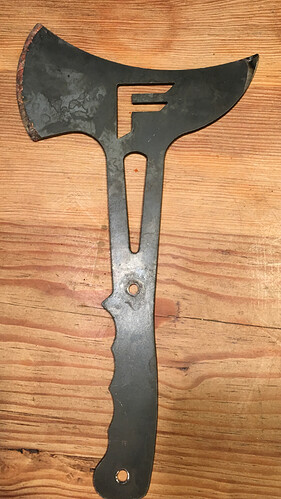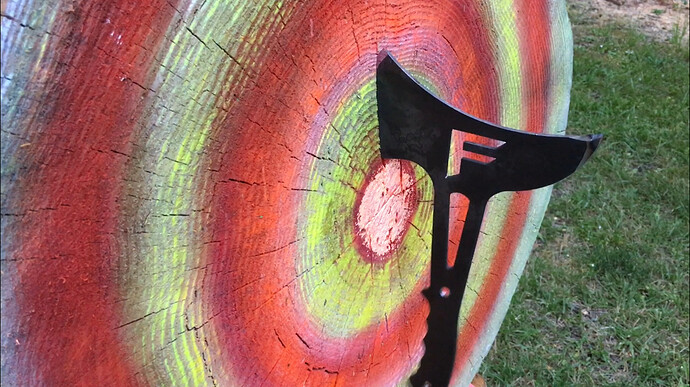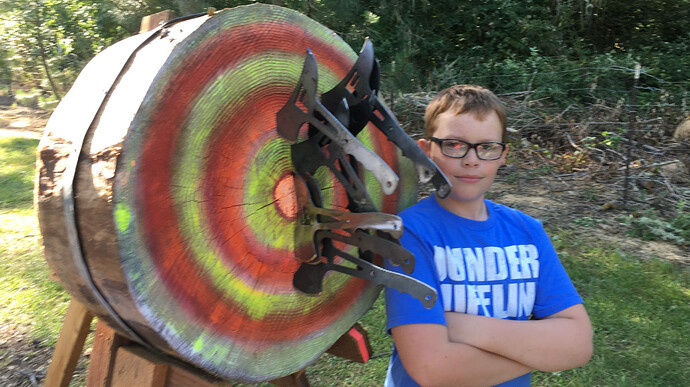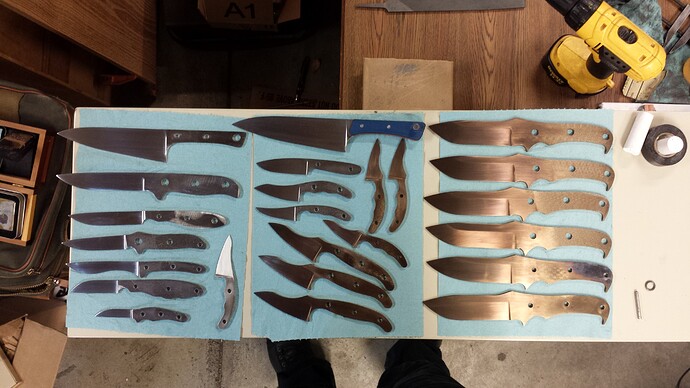Just wongering if anyone had any advise/info on this. I just want to make a few different ones for myself. Thanks in advance, Jim
Made a set of 3 throwing knives for a buddy who’s into hatchet and axe throwing… I just used 3/16" hot rolled… The deal was, I’d cut them and, he’d sharpen them how he wants… I dont have the equipment to sharpen them… Not to mention the HRS I used doesn’t have a high enough carbon content to harden enough for a proper knife… But, for throwing into an end cut of a log, they worked out great… I think they came out to around 9"-10" long… Throwing Knife v5.dxf (858.9 KB)
I wanted to make a few throwing tomahawks for an event we were hosting. I cut two test pieces out of 10 guage HR mild steel and then two out of 1075 that I had the intention of heat treating. The mild steel pieces were super fun to throw and worked so well that I cut 10 more. They get a little dinged up but only take a minute to re-dress. I’ve had three different people ask if I’d make them a set.
Very cool, did you make a 550 cord handle or anything or leave it the way it is?
I left the handles plain. I cut holes in the handle thinking I might add scales but paracord would be easy and look pretty cool. These are getting so much use that I don’t think it would be worth the effort to make them really nice just to get beat up. But I like the paracord idea and just might do that to the ones I cut out of 1075 and keep them for personal use. ![]()
Those look great!! I think I’d like to make a set or two and let the bags game take a rest!! LOL 
This is my process:
Sign up at knifeprint.com
Design my knife
Export my design as a png
Import into Fusion360 as a canvas
Trace using the spline tool slightly oversized.
Cut it out.
Grind to final shape and build knife.
In case the OP or anyone else is looking for knife making advice…
I’ve made a few knives, but not with my plasma cutter. I’ve ground them out by hand, cut them on my CNC mill, and had them cut on a water jet. I’ve done some of my own heat treating and tempering, though due to my preference for exotic steels with extremely high hardening temperatures and necessary cryo treatments, I’ve sent the vast majority out to be heat treated at Peter’s Heat Treating in Pennsylvania.
The most important advise I can give you is to either keep to less exotic steels, or be prepared to temper them after you cut them out. The heat affect zone (HAZ) will be much harder than the rest of the blank, and as you get more exotic steels that will start to make it hard for you to work the blank with normal abrasives, drill bits, reamer, etc without being really hard on them until you get through the HAZ.
Medium and high carbon steels, cut on a plasma with a water table should be ok, but avoid cutting holes, just stick to cutting the outer profile. Be prepared for the cleanup sanding around the perimeter to take a fair bit more elbow grease, and abrasives.
If you have dreams of cutting CPM-3V (my favorite general purpose knife steel) or CPM-S90V (my favorite stainless, high wear resistance knife steel), be prepared to temper way back, or even better, anneal the blanks after cutting. If you’re just doing one you might get through it without tempering and not hate the experience too God aweful bad, but doing a few would result in a LOT of wasted time, abrasives, and possibly drill bits.
Another factor to consider as you go up in carbon and alloy content is the potential for micro cracks along the cut edge because of the rapid cooling of the material along the edge after the cut. If you don’t completely grind these off/out they can propegate during the heat treating process and result in a cracked blade when it is quenched.
There are a lot of smart knife makers out there that know way more than me, but I’m happy to share whatever knowledge I do have if anyone is trying to make a knife.
These are some of my designed ones, and some ones I salvaged out of the scrap from the sheet that the others were cut from. They’re all CPM-3V.




